| Article ID | Journal | Published Year | Pages | File Type |
|---|---|---|---|---|
| 222492 | Journal of Environmental Chemical Engineering | 2013 | 7 Pages |
The present study provided a quantitative comparison between chemical precipitation and electrocoagulation (EC) for removal of heavy metals such as Fe, Al, Ca, Mg, Mn, Zn, Si, Sr, B, Pb, Cr and As from coal mine drainage wastewater (CMDW) at a laboratory scale. The optimum pH for removal of most of heavy metals from CMDW by the chemical precipitation using sodium hydroxide was 8 except for Ca, Sr and B (pH 10 or higher). The removal efficiencies at the optimum pH were varied from 28.4% to 99.96%. Influence of current density and operating time in the EC process was explored on the removal efficiency and operating cost. Results from the EC process showed that the removal of metals present in CMDW increased with increasing current density and operating time. The EC process was able to achieve higher removal efficiencies (>99.9%) at an electrocoagulation time of 40 min, a current density of 500 A/m2 and pH of 2.5 as compared to the results obtained with the chemical precipitation at pH 8. The operating costs at the optimum operating conditions were also determined to be 1.98 €/m3 for the EC and 4.53 €/m3 for the chemical precipitation. The EC process was more effective than the chemical precipitation with respect to the removal efficiency, amount of sludge generated and operating cost. Electrocoagulation has the potential to extensively eliminate disadvantages of the classical treatment techniques to achieve a sustainable and economic treatment of polluted wastewater.
